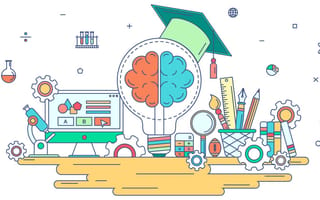For managers, a focus on leadership and investment in growth can often be applied to everyone — except themselves.
Continuous learning and self-improvement have proven essential — and profitable — for companies. That doesn’t just begin and end with onboarding; it’s a continuous process for everyone, including leadership.
However, in a survey conducted by the Center for Organization and Management Effectiveness, leaders spent an average of 30 minutes per day on their own training and development.
Investments in one’s continuous education are vital, regardless of seniority or position.
Meanwhile, according to a 2022 TalentLMS survey, 51 percent of HR managers said that the key to addressing skills gaps was training existing employees, compared to the 31 percent who said the solution lies in hiring new team members.
In technology, an industry that by nature lives and breathes new concepts and ideas, learning and development needs to be a perpetual focus, not an afterthought. For Conga’s Senior Director of UX and Design Michaela Ulibarri, self-development is a necessity.
“Continuous learning inspires me to push the envelope and expand great design in our software. My team is on the cutting edge, and I need to be there as an informed resource and supporter — a bit ahead, seeing around corners whenever possible,” Ulibarri said.
Ulibarri and three other senior leaders shared how their company cultures enable team members to grow their skill sets, and why they make a conscious effort to prioritize their learning.
Scaled Agile’s SAFe provides a framework for enterprise agility that helps organizations improve systems, foster employee engagement and reach business goals.
Between the demands of leading and managing a team and executing on strategy, it can be difficult to find time to prioritize your own learning and development as a senior leader. How do you ensure you find the time to do so in the workplace?
At Scaled Agile, we foster a learning culture where everyone is encouraged to discuss their development goals and create a plan with their manager, regardless of their position. We believe that both the individual and the manager should co-own the development plan, and I take responsibility for continuously learning, receiving feedback and growing. Additionally, we have access to various leadership and executive coaches to support our development. I purposely plan learning and development in my capacity each quarter and reassess needs quarterly.
We believe that both the individual and the manager should co-own the development plan, and I take responsibility for continuously learning, receiving feedback and growing.”
How does your company culture enable you to do so?
At Scaled Agile, we foster a culture of continuous learning. We prioritize thought leadership and organize conferences for our customers and partners. We also encourage our team to stay up to date with industry trends and standards to maintain our position as a leader and innovator.
Our employees have access to education and tuition reimbursement, as well as SAFe training. We implement SAFe throughout our organization and strive for agility in our work. We are constantly improving our SAFe framework and courses, providing ample opportunities for growth and development.
How does prioritizing your own learning and development make you a better leader or manager of people?
Improving one’s leadership skills can be achieved by being a continuous learner. There are various ways to do this, such as reading new books, attending webinars or conferences, participating in training and obtaining certifications. It is crucial to constantly acquire new and diverse skills to advance in your career and the leadership pipeline and to become the best leader you can be. Prioritizing learning and development activities can help you excel as a leader and benefit your team and organization. As your leadership skills evolve, you will need to acquire more advanced skills, such as dynamic change leadership, engaged executive presence, emotional awareness and consistent execution.
Conga is a revenue lifecycle management solution that removes the complexity of order configuration, execution, fulfillment and contract renewal processes.
Between the demands of leading and managing a team and executing on strategy, it can be difficult to find time to prioritize your own learning and development as a senior leader. How do you ensure you find the time to do so in the workplace?
For me, it’s all about carving out time with intention. It’s a challenge because I have the bad habit of giving away time meant for myself. I attempt to block Friday afternoons from meetings and other distractions. I schedule lunch hours to eat and catch up on industry news and information. I also make time for bi-monthly lunches with female friends in the industry. As we know, prioritizing time becomes increasingly difficult — but critical — as we take on greater responsibility. It’s an area I need to continue to improve upon — no lie.
How does your company culture enable you to do so?
Our culture is founded on the Conga Way, our values system and our way of operating. One of the three aspects of the Conga Way is entrepreneurial spirit, and, as part of that, we embrace being lifelong learners and experimenting with new and different approaches. My leadership supports these practices and gives me the space and time for professional growth. Conga encourages everyone to learn about and foster a growth mindset and sponsors a wide variety of development opportunities.
I’ve taken advantage of educational stipends and attended industry conferences. In March, I completed a three-day leadership workshop with my peers from across the company and the world. And the company’s Women in Tech ERG serves as another resource for learning, dialogue and connecting with colleagues. The breadth of opportunity is stellar.
Prioritizing my learning and development fuels my curiosity, challenges my current thinking, processes and default ways of doing things.”
How does prioritizing your own learning and development make you a better leader or manager of people?
Prioritizing my learning and development makes me a better leader in several ways. It fuels my curiosity, challenges my current thinking, processes and default ways of doing things, and helps me become a role model that demonstrates learning investments with my team and others across Conga. New tools and procedures are never-ending, particularly in the design world.
Continuous learning inspires me to push the envelope and expand great design in our software. My team is on the cutting edge, and I need to be there as an informed resource and supporter — a bit ahead, seeing around corners whenever possible.
Cin7 is on a mission to simplify customer inventory management. The SaaS provider connects brands to an ecosystem of suppliers, sales channels, marketplaces and applications.
Between the demands of leading and managing a team and executing on strategy, it can be difficult to find time to prioritize your own learning and development as a senior leader. How do you ensure you find the time to do so in the workplace?
Personal growth is a battle between my prefrontal cortex — my slower, wiser executive — and my limbic system, fast and indulgent. Engaging my prefrontal cortex allows growth. My limbic system just helps me get stuff done quickly — while rewarding, it’s not growth. Personal growth requires strategy, analysis, goal setting and so on.
Intention will always take a backseat to the day’s demands unless I push back to make room for quiet. I do this by scheduling blocks in my day to get into the flow — no Slack, no meetings, just deep work. I sometimes take a minute to close my eyes and let ‘urgent’ thoughts push in, so I can look at them objectively. I also embrace micro-learning: bite-sized activities like a podcast, catching up on peer networks or an article I subscribe to.
Finally, I’m really trying to build reflective practices into my conversations. Having a roster of questions I can ask in any meeting helps me get a clearer view of myself or the situation. Asking “What do I not know?” and “How can I get better?” always returns some new positive, challenging or growth-oriented insight. It also helps model reflective practices for my teams — a double win.
Personal growth requires strategy, analysis, goal setting and so on. Intention will always take a backseat to the day’s demands unless I push back to make room for quiet.”
How does your company culture enable you to do so?
I’ve never — never ever — worked for a company that supported personal growth more than at Cin7. It’s lazy just to fund people going elsewhere to learn, and doing so doesn’t build into the company’s culture. Cin7 has found so many channels to create a positive feedback loop encompassing growth while building the culture at Cin7.
It’s going to be easier to just list all the things I’ve seen and experienced in my trip around the sun at Cin7. We have internally created L&D programs such as workshops, panel discussions, webinars and an entire education department. Much of my time this year has been spent on rolling out a mentoring program. We use really great tools like CultureAmp to facilitate constant feedback, enabling internal and upward mobility at Cin7. External education has its place. A colleague of mine is putting together a program to put rails on support for continued external education.
There are so many opportunities to seize to recognize the good work of peers, encourage innovation and creativity and reward people for demonstrating our values. All these things create this incredible virtuous cycle which is intoxicating to be a part of and to contribute to progress.
How does prioritizing your own learning and development make you a better leader or manager of people?
I want to foster a culture of growth and improvement at Cin7. When team members observe leaders prioritizing learning, they are encouraged to do the same, resulting in a more engaged, motivated workforce. This can foster an environment where knowledge-sharing and cross-functional collaboration thrives. We’ve all been in cutthroat work environments where information is hoarded; it shreds you.
I see personal growth as cultivating self-awareness and emotional intelligence, enabling better communication and collaboration with my team. By understanding my own strengths, weaknesses and biases, I can effectively leverage the strengths of others, delegate tasks efficiently and address conflicts constructively.
Investing in my own growth demonstrates a commitment to self-improvement, which can enhance my credibility and influence as a leader. When team members see my dedication to learning, they are more likely to respect and trust my guidance, fostering a positive working relationship. Prioritizing personal L&D allows me to make informed decisions and provide valuable guidance to my teams. Staying updated on industry trends equips me with relevant insights to navigate changing landscapes.
Matillion’s user-friendly, cloud-native data integration platform helps clients around the world transform data into valuable insights. Matillion allows employees to choose when they come into the office and when they work remotely.
Between the demands of leading and managing a team and executing on strategy, it can be difficult to find time to prioritize your own learning and development as a senior leader. How do you ensure you find the time to do so in the workplace?
I feel that in my role, it is critical for me to continue and learn the new developments and trends and be up to date on research in my field. To do this, I make sure to participate in different people’s forums. I participate in sessions on topics that are interesting to me. This is challenging as when my day gets busy; it is tempting to cancel, but I make an effort to attend and share with my team as well.
In addition, I make sure to read articles at least once a week on matters I want to learn more about. If I don’t have time, I mark the articles I want to read and close the time in my calendar.
It is critical for me to continue and learn the new developments and trends and be up to date on research in my field. I participate in sessions on topics that are interesting to me.”
How does your company culture enable you to do so?
One of our values is “We innovate and demand quality.” We believe no product, process or individual is ever finished. This encourages individual contributors and leaders across the organization to focus on learning, improvement and innovation regardless of their experience. We have a talent development team in my function that is central to driving our culture of continuous improvement and learning across the business. They deliver live training, which starts with our Onboarding Academy through to our highly effective Matillioner program, as well as offering Matillioners across the business access to Blinkist, A Cloud Guru and Udemy for Business to take e-learning sessions or read a book summary.
I’ll admit that I don’t use some of these resources enough, but I do regularly search topics in Blinkist that I am interested in learning more about and read or listen to a shorter version of a book when I don’t have time to read the whole thing. We also actively encourage Matillioners to attend external events to keep on top of their own knowledge or changes in the market, such as Engineering, LeadDev, Women in Tech, Big Data London and many more. Our CEO regularly talks about our team being the most important asset of this business, which I totally agree with. So we are always striving for ways to make sure they always have access to opportunities to learn, develop, grow and ultimately be the best version of themselves here at Matillion.













